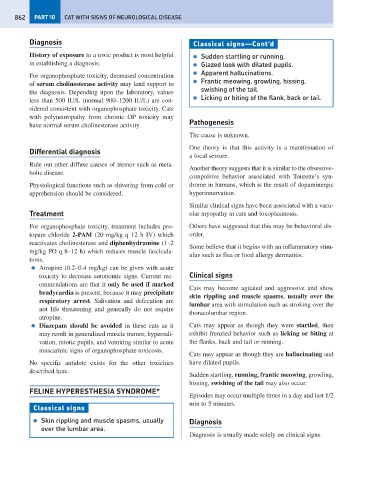Page 870 - Problem-Based Feline Medicine
P. 870
862 PART 10 CAT WITH SIGNS OF NEUROLOGICAL DISEASE
Diagnosis Classical signs—Cont’d
History of exposure to a toxic product is most helpful ● Sudden startling or running.
in establishing a diagnosis. ● Glazed look with dilated pupils.
● Apparent hallucinations.
For organophosphate toxicity, decreased concentration
● Frantic meowing, growling, hissing,
of serum cholinesterase activity may lend support to
swishing of the tail.
the diagnosis. Depending upon the laboratory, values
● Licking or biting of the flank, back or tail.
less than 500 IU/L (normal 900–1200 IU/L) are con-
sidered consistent with organophosphate toxicity. Cats
with polyneuropathy from chronic OP toxicity may
have normal serum cholinesterase activity. Pathogenesis
The cause is unknown.
One theory is that this activity is a manifestation of
Differential diagnosis
a focal seizure.
Rule out other diffuse causes of tremor such as meta-
Another theory suggests that it is similar to the obsessive-
bolic disease.
compulsive behavior associated with Tourette’s syn-
Physiological functions such as shivering from cold or drome in humans, which is the result of dopaminergic
apprehension should be considered. hyperinnervation.
Similar clinical signs have been associated with a vacu-
Treatment olar myopathy in cats and toxoplasmosis.
For organophosphate toxicity, treatment includes pro- Others have suggested that this may be behavioral dis-
topam chloride 2-PAM (20 mg/kg q 12 h IV) which order.
reactivates cholinesterase and diphenhydramine (1–2
Some believe that it begins with an inflammatory stim-
mg/kg PO q 8–12 h) which reduces muscle fascicula-
ulus such as flea or food allergy dermatitis.
tions.
● Atropine (0.2–0.4 mg/kg) can be given with acute
toxicity to decrease autonomic signs. Current rec- Clinical signs
ommendations are that it only be used if marked
Cats may become agitated and aggressive and show
bradycardia is present, because it may precipitate
skin rippling and muscle spasms, usually over the
respiratory arrest. Salivation and defecation are
lumbar area with stimulation such as stroking over the
not life threatening and generally do not require
thoracolumbar region.
atropine.
● Diazepam should be avoided in these cats as it Cats may appear as though they were startled, then
may result in generalized muscle tremor, hypersali- exhibit frenzied behavior such as licking or biting at
vation, miotic pupils, and vomiting similar to acute the flanks, back and tail or running.
muscarinic signs of organophosphate toxicosis.
Cats may appear as though they are hallucinating and
No specific antidote exists for the other toxicities have dilated pupils.
described here.
Sudden startling, running, frantic meowing, growling,
hissing, swishing of the tail may also occur.
FELINE HYPERESTHESIA SYNDROME*
Episodes may occur multiple times in a day and last 1/2
min to 5 minutes.
Classical signs
● Skin rippling and muscle spasms, usually Diagnosis
over the lumbar area.
Diagnosis is usually made solely on clinical signs.

